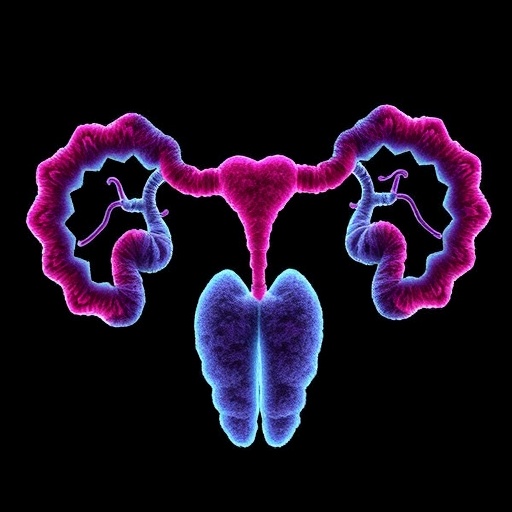In a groundbreaking study published in the Journal of Ovarian Research, researchers have unveiled an innovative approach to combatting chemoresistant high-grade serous ovarian cancer. This aggressive form of cancer has long posed significant challenges to treatment, often showing a resistance to conventional therapies. The research team, led by Sun et al., has demonstrated the potential of a novel drug combination using repurposed medications—copanlisib and cerivastatin—highlighting their synergistic effects in overcoming this resistance.
Ovarian cancer remains one of the leading causes of cancer-related mortality among women worldwide. High-grade serous ovarian cancer is particularly notorious for its late-stage diagnosis and poor prognosis. Current treatment regimens typically involve a combination of surgery and chemotherapy, but many patients experience relapse due to the cancer becoming resistant to drugs. The urgent need for new therapeutic strategies is underscored by the pressing statistics surrounding this disease.
The researchers embarked on a comprehensive, unbiased combination screening of repurposed drugs to identify potential candidates that could work synergistically against cancer cells. Repurposing existing drugs can significantly accelerate the drug development process, as these medications have already undergone safety testing and are familiar to clinicians. In their study, the team systematically assessed various drug combinations to evaluate their efficacy in arresting the growth of chemoresistant ovarian cancer cells.
Results from the study revealed a remarkable synergistic effect when copanlisib, a PI3K inhibitor, was combined with cerivastatin, a drug originally designed to lower cholesterol. Early laboratory tests indicated that this combination not only inhibited cancer cell proliferation but also promoted apoptosis, or programmed cell death, in resistant ovarian cancer cells. The researchers detailed how the dual-action of these drugs interferes with critical survival pathways in the cancer cells, making them more vulnerable to treatment.
Intriguingly, the mechanism behind the effectiveness of this drug combination lies in their ability to target different signaling pathways within the cancer cells. Copanlisib acts on the PI3K/AKT/mTOR pathway, which is often hyperactivated in various cancers, while cerivastatin impacts the mevalonate pathway, essential in cellular proliferation and survival. By simultaneously targeting these distinct pathways, the drugs collaboratively enhance the anti-cancer effects, leading to more potent responses than when either drug is used alone.
In this study, the authors also emphasized the importance of personalized medicine in cancer treatment. Individual variations in tumor biology mean that not all patients will respond uniformly to standard therapies. The identification of synergistic drug combinations such as copanlisib and cerivastatin offers a promising avenue for tailoring treatment options to the unique molecular profile of each patient’s cancer, potentially improving outcomes significantly.
The findings have generated excitement within the scientific community, as they provide robust evidence supporting the exploration of repurposed drugs in oncology. This study could pave the way for more extensive clinical trials to evaluate the safety and efficacy of this combination in patients with chemoresistant high-grade serous ovarian cancer. Importantly, the preclinical results underscore the necessity of moving swiftly to clinical applications that can address the unmet medical needs of affected patients.
Furthermore, the team acknowledged the role of advanced screening techniques and modern biochemistry in uncovering these promising combinations. Leveraging high-throughput screening methods and in-depth mechanistic studies has allowed for precise identification of effective drug pairings that might have otherwise been overlooked. As cancer research continues to evolve, such methodologies will play a crucial role in the quest for more effective treatments.
The study’s implications extend beyond just ovarian cancer, as the principles of drug repurposing and combination therapy may be applicable to a myriad of other malignancies that currently pose therapeutic challenges. The hope is that similar approaches can be tailored to other resistant tumors, broadening the impact of their research and offering new hope to patients worldwide.
As the oncology field moves forward, lessons learned from this investigation could catalyze a shift in how cancer treatments are developed, assessed, and administered. The critical takeaway from Sun et al.’s study is that the collaborative potential of existing drugs can yield novel therapeutic strategies, particularly when it comes to tackling the intricacies of drug resistance in cancer.
This study serves not only as a beacon of hope for patients battling chemoresistant ovarian cancer but also as a reminder of the untapped potential that lies within existing pharmacological agents. Continued research is essential in unveiling the intricate interactions between drugs and cancer cells, steering the focus towards a preference for combination therapies that exploit synergistic mechanisms.
In conclusion, the findings from this research highlight a promising strategy in the fight against one of the most challenging cancers. By utilizing repurposed drugs such as copanlisib and cerivastatin, there’s a transformative potential to redefine how chemoresistant high-grade serous ovarian cancer is approached, offering renewed optimism for patients and clinicians alike.
Subject of Research: Synergistic potential of copanlisib and cerivastatin against chemoresistant high-grade serous ovarian cancer.
Article Title: Unbiased combination screening on repurposed drugs reveals synergistic potential of copanlisib and cerivastatin against chemoresistant high-grade serous ovarian cancer.
Article References:
Sun, Y., Wang, Y., Umbreen, S. et al. Unbiased combination screening on repurposed drugs reveals synergistic potential of copanlisib and cerivastatin against chemoresistant high-grade serous ovarian cancer.
J Ovarian Res 18, 242 (2025). https://doi.org/10.1186/s13048-025-01828-7
Image Credits: AI Generated
DOI: https://doi.org/10.1186/s13048-025-01828-7
Keywords: ovarian cancer, chemoresistance, copanlisib, cerivastatin, drug repurposing, combination therapy.




